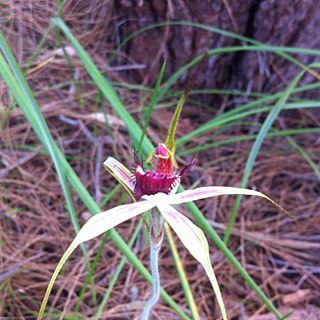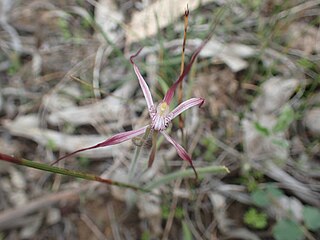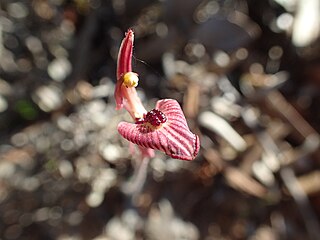
Caladenia latifolia, commonly known as pink fairies is a species of orchid endemic to Australia and is common and widespread in the southern half of the continent and in Tasmania. It has a single, hairy leaf and up to four pink flowers. It is easily distinguished by its relatively large, green leaf, and pink flowers on an unusually tall spike.

Caladenia cruscula, commonly known as the reclining spider orchid is a species of orchid endemic to a small area in the south-west of Western Australia. It has a single hairy leaf and a single cream-coloured flower with a long red fringe on the sides of its labellum.

Caladenia ensata, commonly known as the stumpy spider orchid, is a species of orchid endemic to the south-west of Western Australia. It is a common orchid within its natural range and has a single, hairy leaf and up to three pale yellow and red flowers which have short but thick, fleshy glandular tips.

Caladenia footeana, commonly known as the crimson spider orchid is a species of orchid endemic to the south-west of Western Australia. It has a single, hairy leaf and one or two, relatively small pinkish-red flowers with a white, red-striped labellum. Its relatively small size makes it hard to find in its surroundings.

Caladenia gardneri, commonly known as the cherry spider orchid, is a species of orchid endemic to the south-west of Western Australia. It has a single, hairy leaf and up to three pale pink, sweetly scented flowers with a dark pinkish-red labellum.

Caladenia georgei, commonly known as the tuart spider orchid, is a species of orchid endemic to the south-west of Western Australia. It has a single, hairy leaf and up to three whitish to yellowish-green flowers flushed with red and which have a white labellum with a red tip.
Caladenia harringtoniae, commonly known as the pink spider orchid, is a species of orchid endemic to the south-west of Western Australia. It has a single, hairy leaf and up to three pale to deep pink flowers which have a cream-coloured labellum with a pink tip.

Caladenia heberleana, commonly known as Heberle's spider orchid, is a species of orchid endemic to the south-west of Western Australia. It has a single, hairy leaf and up to three red, white and pale yellow flowers which have a white, red-tipped labellum.
Caladenia hoffmanii, commonly known as Hoffman's spider orchid is a species of orchid endemic to the south-west of Western Australia. It has a single, hairy leaf and one or two, greenish-yellow, red and white flowers which have a greenish-yellow labellum with a red tip. It is distinguished from the Pingaring spider orchid by small differences in the labellum and more northerly distribution.
Caladenia incrassata, commonly known as the puppet clown orchid is a species of orchid endemic to the south-west of Western Australia. It has a single, hairy leaf and usually only one greenish-yellow and red flower which has a red-striped labellum.
Caladenia interjacens, commonly known as the Walpole spider orchid is a species of orchid endemic to the south-west of Western Australia. It has a single, hairy leaf and one or two pale pink and white flowers which lack the red tip on the labellum common to many other similar caladenias.
Caladenia lodgeana, commonly known as Lodge's spider orchid, is a species of orchid endemic to a restricted area of the south-west of Western Australia. It has a single, hairy leaf and up to three cream, red and pink flowers and a labellum which lacks the red tip common to many other similar caladenias.

Caladenia applanata subsp. applanata, commonly known as the broad-lipped spider orchid, is a species of orchid endemic to the south-west of Western Australia. It is a relatively common orchid with a single erect, hairy leaf and up to three flowers which may be red, cream, green or yellow and have a broad, flattened, red-tipped labellum.

Caladenia attingens subsp. attingens, commonly known as the forest mantis orchid or sneezing spider orchid, is a species of orchid endemic to the south-west of Western Australia. It is a relatively common orchid with a single erect, hairy leaf and one or two green, yellow and red flowers. It is similar to the fringed mantis orchid but has smaller flowers and has a more southerly distribution.

Caladenia attingens subsp. gracillima, commonly known as the small mantis orchid, is a species of orchid endemic to the south-west of Western Australia. It is a relatively common orchid with a single erect, hairy leaf and one or two green, yellow and red flowers. It differs from subspecies attingens in having smaller flowers and a more easterly distribution.

Caladenia lorea, commonly known as the blushing spider orchid, is a species of orchid endemic to the south-west of Western Australia. It has a single, hairy leaf and up to three cream, pink and red flowers and often hybridises with the white spider orchid producing intermediate forms.

Caladenia nivalis, commonly known as the exotic spider orchid or crystalline spider orchid, is a species of orchid endemic to the south-west of Western Australia. This orchid is easily distinguished by its bright white to pale pink and red flowers and its narrow range in and near the Leeuwin-Naturaliste National Park.

Caladenia occidentalis, commonly known as the ruby spider orchid, is a species of orchid endemic to the south-west of Western Australia. It has a single erect, hairy leaf and one or two pinkish-red flowers with a white, red-striped labellum.

Caladenia pachychila, commonly known as the dwarf zebra orchid, is a species of orchid endemic to the south-west of Western Australia. It has a single erect, hairy leaf and one or two greenish-yellow and red flowers with a red-striped labellum which has a dense cluster of deep purple calli in its centre. It is similar to the zabra orchid but has smaller flowers and the lateral sepals do not clasp the ovary.
Caladenia pholcoidea subsp. augustensis, commonly known as the Augustus spider orchid, is a plant in the orchid family Orchidaceae and is endemic to the south-west of Western Australia. It is a rare orchid with a single hairy leaf and up to three mostly white flowers with long spreading petals and lateral sepals.
























